May 18, 2013
by Carole Zangari -
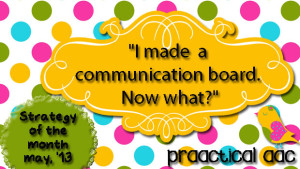
Earlier this month, we shared some ideas for making communication boards using color coding and also for creating boards geared to different communicative purposes. Making the communication board according to some basic principles is a good thing, of course, and it takes a decent amount of thought and planning. Even more important, though, is developing an intervention plan so that the augmentative communicator learns how to use the board effectively. Here are some of our thoughts on how to teach someone to use a new communication board. Model It We’ve talked about aided language input so many times that I’m almost embarrassed to mention it. Almost. The truth is, it is a ‘must do’ strategy when we’re first introducing a communication board, book, SGD, or AAC app. Incidental learning is important for just about all of the people with whom we work. It is never the only strategy we use,... [Read More...]
Filed under: Strategy of the Month
May 11, 2013
by Robin Parker -
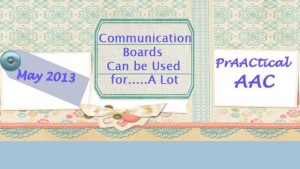
When we think of AAC and communication boards or displays, we often think of comprehensive core and fringe words. We think of a board that will represent the most possible communication functions, vocabulary, and generative language. However, there are many other ways to create and use communication boards. There are many other ways because there are many reasons we communicate and sometimes it is best to create a communication board that focuses on a specific communication need. AAC is not one thing but a system of communication supports, and for most AAC users, there should be a multitude of communication options that will aid in robust communication and language needs. All AAC users should have a comprehensive individual communication display whether low tech (communication book) or high-tech (AAC device or App). But…. many AAC users will also benefit from communication boards that support a specific communication purpose. The reason for... [Read More...]
Filed under: Strategy of the Month
Tagged With: COmmunication Books, gossip, small talk, specific communication functions, story telling
May 4, 2013
by Carole Zangari -
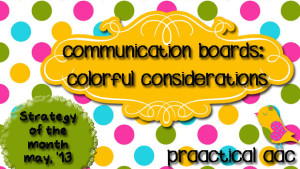
We love AAC technology and are deeply grateful for the options that are available to people with significant communication difficulties. We’re strong supporters of voice output systems and the autonomy they give to the children and adults with whom we work. On the other hand, we have great respect and much fondness for the “no tech” communication aids and visual supports. As a student clinician, I made my first conversation book for Sherri, a young lady who had learned Bliss at school but had no communication materials in the institution where she was living. In my days as a clinical fellow, I got ratted out by Davey, a client who used his 100-location Bliss board to tell the supervisor that I gave out seconds on coffee even though the rule was one cup per person. (I knew I should never have taught him interjections!) There’s no doubt – communication boards... [Read More...]
Filed under: Strategy of the Month
Tagged With: color, color coding, communication book, Crain, Elder, Fitzgerald Key, Goossens', no tech, strategy
April 27, 2013
by Robin Parker -
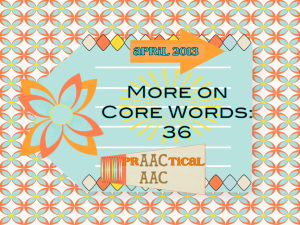
This month we have talked about core words and teaching strategies & considerations for facilitating USING core language. We have talked about aided language input, creating frequent opportunities, making connections b/w symbols and their referents, and motor planning/automaticity. As April ‘goes out’, we add graduated prompting/prompt hierarchies, and wait & signal/time delay prompts. The key to teaching AAC core word language is strategies…. Aided language input (ALI) is fairly simple to do but sometimes overlooked. However, once it becomes habit, it is hard not to do even when you are ‘just’ talking about AAC displays. There are many clinical rationales or reasons why ALI is so important. It provides a model of the language we expect from the child (or adult), and how would anyone speak a language if they never ‘heard’ it. ALI also helps by introducing new words and symbols in meaningful contexts. If we are speaking AAC throughout the day then... [Read More...]
Filed under: Strategy of the Month
Tagged With: core vocabulary, meaningful language experiences
April 20, 2013
by Carole Zangari -
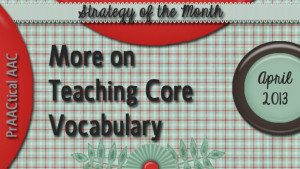
Last week, we talked about two key strategies for teaching core language: using aided language input and creating frequent opportunities to teach and elicit core words. In today’s post, we’ll expand the number of words and discuss two additional considerations for teaching core words. Aided language input is always important in working with beginning users of AAC. It exposes them to their new means of communication, provides them with a competent model of their AAC system, and introduces them to words and symbols they don’t yet know within a meaningful context. It also forces us to slow down when talking, something that can be very beneficial when you consider that many beginning users of AAC also have difficulty processing oral language. (It may take them longer to decode what they’re hearing and they may have to concentrate more than the average kid.) If you’ve actually tried pointing to symbols as... [Read More...]
Filed under: Strategy of the Month
Tagged With: core language, core vocabulary, semantic instruction
April 13, 2013
by Robin Parker -
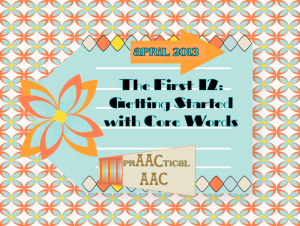
The focus this month is on core word vocabulary and effective teaching strategies. Most core vocabulary is represented through abstract symbols that range from translucent (i.e., makes sense after it is explained) to opaque (i.e., doesn’t have any resemblance to the word or concept) which makes the need for effective teaching all the more important. It also makes it more fun because meaningful language experiences, emotional language experiences, and repetition with variety experiences are going to be the platform for teaching. Within the platform of authentic language experiences, layers of teaching strategies can be applied. The more strategies we apply to learning, the more we assure ALL learners will benefit from our teaching. Core word vocabulary teaching begins with a few premises that underlie the process. These are not new ideas but ones that should be reaffirmed as you begin teaching. It is important, as always, to presume competence. All learners... [Read More...]
Filed under: Strategy of the Month
Tagged With: AAC Teaching Strategies
April 6, 2013
by Carole Zangari -
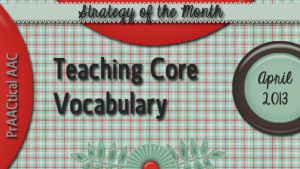
Among the many changes that the AAC field has experienced in the last decade is the notion that core vocabulary is (or should be) an integral part of any AAC system. We grew to understand the limitations of AAC supports that consist primarily of nouns and descriptors, realizing that those kinds of communication displays restricted our clients to requesting and labeling. Our field realized the inadequacy of providing only prestored messages (e.g., limited the client’s ability to communicate anything novel, not flexible enough to meet most communication needs, etc.). In essence, we realized that without core vocabulary, we were imposing a ceiling on language development. We’re thrilled to see so many communication boards, books, SGDs, and AAC apps reflect this knowledge. Having tools with the appropriate vocabulary is a big step in the right direction. But to really shatter the ceiling of language development, we have to be good at... [Read More...]
Filed under: Strategy of the Month
Tagged With: core language, core vocabulary, instructional sequence, vocabulary instruction
March 30, 2013
by Carole Zangari -
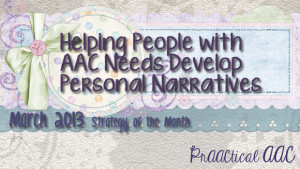
Where I come from, we value our independence. We look forward to the day when we can move out of our childhood homes into our first apartments. We’re intensely proud of our kids when they first do things on their own. We feel honored do to our first professional presentations or fly solo on a publication. We are driven to be independent in our professional and personal lives. Independence is all well and good, but sometimes we get caught up in thinking that it’s the most important thing for our clients who use AAC. Many times, it’s not. As SLPs well know, communication is a social act. Without the cooperation of another person, there is no communication.We need other people in order to communicate and we need them even more when we’re just learning. Independence is something, but it isn’t everything. For AAC learners, interdependence plays an important role. We love... [Read More...]
Filed under: Strategy of the Month
Tagged With: co-construction, download, language therapy, narrative, storytelling, visual supports
March 23, 2013
by Robin Parker -
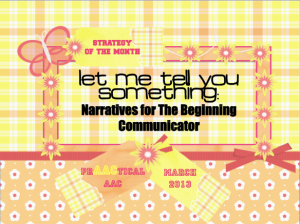
March continues with story telling or narratives as the Strategy of the Month. All learners have stories to tell but some may need special teaching to be able to express their stories. Goals for the beginning communicator can and should include narratives. Personal narratives are a good place to begin but any type of narrative can be taught with structure, routines, partner support, prAACtical strategies. Robust communication includes story telling. Yes, beginning communicators need to be able to express wants and needs however, authentic and comprehensive language involves much more. The quicker we start teaching, the quicker beginning communicators (or anyone) can learn. Beginning Communicator Narratives 3 Types (Just some of the options) Remnant Books are a visual and tactile way of telling stories by recording important events. Learners can help choose items from meaningful personal experiences which serve as a reminder of stories to tell. Create routines and visual supports... [Read More...]
Filed under: Strategy of the Month
Tagged With: beginning communicator, narratives, strategies
March 16, 2013
by Carole Zangari -
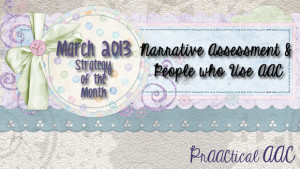
This month, we’ve been talking about building narrative skills in our AAC clients. We tried to build the case that including narrative language goals in our intervention allows us to help people who use AAC to participate more fully in social exchanges, relay more in-depth information, and achieve greater academic success. But how do we know where to start in narrative intervention? And how do we measure progress? In this post, we share some thoughts on the assessment of narrative language in AAC. Most test batteries that assess narrative language are designed to take a snapshot of what the learner has already mastered in terms of telling personal narratives, story retelling, or scripts. This allows us to look beyond MLU, morphology, and grammar and can be useful in determining whether intervention is needed. Some scholars, however, have noted the limitations of this “one shot” approach, particularly for learners whose communication... [Read More...]
Filed under: Strategy of the Month
Tagged With: analysis, assessment, narrative language, Scripts, stories, story grammar









